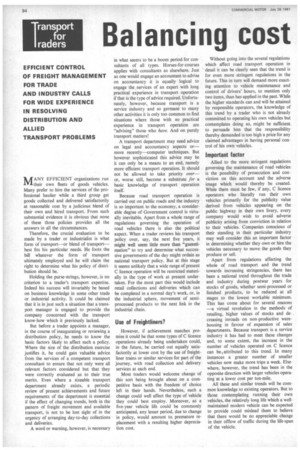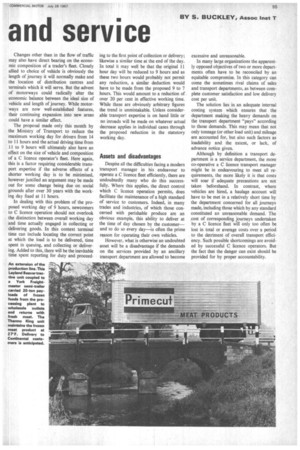Balancing cost
Page 96

Page 97

If you've noticed an error in this article please click here to report it so we can fix it.
and service BY S. BUCKLEY, Assoc Inst T MANY EFFICIENT organizations run their own fleets of goods vehicles. Many prefer to hire the services of the professional haulier while a third group get goods collected and delivered satisfactorily at reasonable cost by a judicious blend of their own and hired transport. From such substantial evidence it is obvious that none of these three policies provides all the answers in all the circumstances.
Therefore, the crucial evaluation to be made by a trader or industrialist is what form of transport—or blend of transport— best fits his particular needs. He foots the bill whatever the form of transport ultimately employed and he will claim the right to ,determine what his policy of distribution should be.
Holding the purse-strings, however, is no criterion to a trader's transport expertise. Indeed his success will invariably be based on business knowledge in some other trade or industrial activity. It could be claimed that it is in just such a situation that a transport manager is engaged to provide the company concerned with the transport know-how which it previously lacked.
But before a trader appoints a manager, in the course of inaugurating or reviewing a distribution policy, he needs to know the basic factors likely to affect such a policy. Where the size of the distribution exercise justifies it, he could gain valuable advice from the services of a competent transport consultant to ensure that not only were all relevant factors considered but that they were correctly evaluated as to their true merits. Even where a sizeable transport department • already exists, a periodic review of present achievements and future requirements of the department is essential if the effect of changing trends, both in the pattern of freight movement and available transport, is not to be lost sight of in the urgency of arranging day-to-day collections and deliveries.
A word or warning, however, is necessary
in what seems to be a boom period for consultants of all types. Horses-for-courses applies with consultants as elsewhere. Just as one would engage an accountant to advise on accountancy it is equally logical to engage the services of an expert with long practical experience in transport operation if that is the type of advice required. Unfortunately, however, because transport is a service industry and so germane to many other activities it is only too common to find situations where those with no practical experience in transport operation are "advising" those who have. And on purely transport matters!
A transport department may need advice on legal and accountancy aspects or— more recently—computer techniques. But however sophisticated this advice may be it can only be a means to an end, namely more efficient transport operation. It should not be allowed to take priority over— or, worse still, become a substitute for a basic knowledge of transport operation itself.
Because road transport operation is carried out on public roads and the industry is so important to the economy, a considerable degree of Government control is virtually inevitable. Apart from a whole range of regulations governing the operation of road vehicles there is also the political aspect. When a trader reviews his transport policy over, say, the next five years, it might well seem little more than "guesstimation" to try and determine what successive governments of the day might ordain as national transport policy. But at this stage it seems unlikely that a wide range of present C licence operation will be restricted materially in the type of work at present undertaken. For the most part this would include retail collections and deliveries which can be completed in a normal day's work, or, in the industrial sphere, movement of semiprocessed products to the next link in the industrial chain.
Use of Freightliners?
However, if achievement matches promise it could be that some types of C licence operations already being undertaken could, in the future, be carried out equally satisfactorily at lower cost by the use of freightliner trains or similar services for part of the journey, with road collection and delivery services at each end.
Most traders would welcome change of this sort being brought about on a competitive basis with the freedom of choice left in their hands. Nevertheless, such a change could well affect the type of vehicle they could best employ. Moreover, as a five-year vehicle life could be commonly anticipated, any lesser period, due to change in policy, would amount to. premature replacement with a resulting higher depreciation cost. Without going into the several regulations which affect road transport operation in detail it can be clearly seen that the trend is for even more stringent regulations in the future. This in turn will demand more exacting attention to vehicle maintenance and control of drivers' hours, to mention only two items, than has applied in the past. While the higher standards can and will be attained by responsible operators, the knowledge of this trend by a trader who is not already committed to operating his own vehicles but contemplates doing so, might be sufficient to persuade him that the responsibility thereby demanded is too high a price for any claimed advantages in having personal control of his own vehicles.
Important factor
Allied to the more stringent regulations governing the maintenance of road vehicles is the possibility of prosecution and conviction on this account and the adverse image which would thereby be created. While there must be few, if any, C licence operators who literally run their own vehicles primarily for the publicity value derived from vehicles appearing on the public highway in their own livery, every company would wish to avoid adverse publicity arising from conviction in relation to their vehicles. Companies conscious of their standing in their particular industry may well consider this an important factor in determining whether they own or hire the vehicles necessary to move the goods they produce or sell.
Apart from regulations affecting the whole of road transport and the trend towards increasing stringencies, there has been a national trend throughout the trade and industry during postwar years for stocks of goods, whether semi-processed or finished products, to be reduced at all stages to the lowest workable .minimum. This has come about for several reasons —a virtual revolution in the methods of retailing, higher values of stocks and decreasing inroads on non-productive warehousing in favour of expansion of sales departments. Because transport is a service industry it has had to meet these changes and, to some extent, the increase in the number of vehicles operated on C licence can be, attributed to this trend. In many instances a greater number of smaller vehicles now make more trips a week. Elsewhere, however, the trend has been in the opposite direction with larger vehicles operating at a lower cost per ton-mile.
All these and similar trends will be common knowledge to existing operators. But to those contemplating running their own vehicles, the relatively long life which a wellmaintained modern vehicle can be expected to provide could mislead them to believe that there would be no appreciable change in their offlow of traffic during the life-span of the vehicle. Changes other than in the flow of traffic may also have direct bearing on the economic composition of a trader's fleet. Closely allied to choice of vehicle is obviously the length of journey it will normally make and the location of distribution centres and terminals which it will serve. But the advent of motorways could radically alter the economic balance between the ideal size of vehicle and length of journey. While motorways are now well-established features, their continuing expansion into new areas could have a similar effect.
The proposal made only this month by the Ministry of Transport to reduce the maximum working day for drivers from 14 to 11 hours and the actual driving time from 11 to 9 hours will ultimately also have an effect on the size of vehicle and composition of a C licence operator's fleet. Here again, this is a factor requiring considerable transport expertise if the adverse effects of a shorter working day is to be minimised, however justified an argument may be made out for some change being due on social grounds after over 30 years with the working day fixed at 11 hours.
In dealing with this problem of the proposed working day of 9 hours, newcomers to C licence operation should not overlook the distinction between overall working day and time actually engaged in collecting or delivering goods. In this context terminal time can include locating the correct point at which the load is to be delivered, time spent in queuing, and collecting or delivering. Added to this, there will be the inevitable time spent reporting for duty and proceed
ing to the first point of collection or delivery; likewise a similar time at the end of the day. In total it may well be that the original 11 hour day will be reduced to 9 hours and as these two hours would probably not permit any reduction, a similar deduction would have to be made from the proposed 9 to 7 hours. This would amount to a reduction of over 20 per cent in effective working time. While these are obviously arbitrary figures the trend is unmistakable. Unless considerable transport expertise is on hand little or no inroads will be made on whatever actual decrease applies in individual cases through the proposed reduction in the statutory working day.
Assets and disadvantages Despite all the difficulties facing a modern transport manager in his endeavour to operate a C licence fleet efficiently, there are undoubtedly many who do this successfully. Where this applies, the direct control which C licence operation permits, does facilitate the maintenance of a high standard of service to customers. Indeed, in many trades and industries, of which those concerned with perishable produce are an obvious example, this ability to deliver at the time of day chosen by the customer— and to do so every day—is often the prime reason for operating their own vehicles.
However, what is otherwise an undoubted asset will be a disadvantage if the demands on the services provided by an ancillary transport department are allowed to become excessive and unreasonable.
In many large organizations the apparently opposed objectives of two or more departments often have to be reconciled by an equitable compromise. In this category can come the sometimes rival claims of sales and transport departments, as between complete customer satisfaction and low delivery cost per unit.
The solution lies in an adequate internal costing system which ensures that the department making the heavy demands on the transport department "pays" according to those demands. This may mean that not only tonnage (or other load unit) and mileage are accounted for, but also such factors as loadability and the extent, or lack, of advance notice given.
Although by definition a transport department is a service department, the more co-operative a C licence transport manager might be in endeavouring to meet all requirements, the more likely it is that costs will soar if adequate precautions are not taken beforehand. In contrast, where vehicles are hired, a haulage account will have to be met in a relatively short time by the department concerned for all journeys made, including those which by any standard constituted an unreasonable demand. The cost of corresponding journeys undertaken by a C licence fleet will only too often be lost in total or average costs over a period to the detriment of overall transport efficiency. Such possible shortcomings are avoided by successful C licence operators. But the fact that the danger can exist should be provided for by proper accountability.




































































































































































